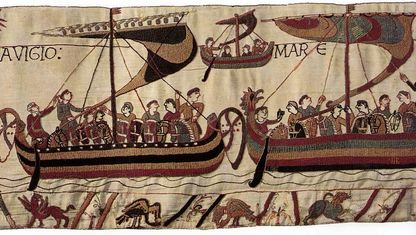

Iconographic sources for the Viking Age
Contemporary images are always good historical sources. Here we actually see in use the artefacts found during archaeological investigations. An insight is gained into power structures and religious perceptions and, in very special cases, there are depictions of unique historical events.
Textiles
One of the most significant pictorial sources for the Viking Age is the Bayeux Tapestry – a 70-metre long and 50 cm high tapestry from the town of Bayeux in Normandy, France. The tapestry is from the 1070s and was commissioned by Bishop Odo on the occasion of the consecration of the town’s cathedral. Bishop Odo was William the Conqueror's half-brother, and the tapestry was produced after the Battle of Hastings when William took the throne in England, perhaps in homage.
The Tapestry's value as a source is manifold. The embroidery on the tapestry is in English style, but the motifs are Nordic and the tapestry does not merely depict the Battle of Hastings but also the preparations for the conquest of England. All the images are accompanied by a Latin text.
On the tapestry, we can see how the ships were manned, how the warriors were equipped, and that William took horses on board. The tapestry also depicts the negotiations that we can read about in the written sources and in this way the sources support each other.
The shipbuilding scene was important for the reconstruction of the Sea Stallion because it not only reveals the appearance of the ship and how it was ornamented but also shows boat builders with axes, planes and materials in their hands. In this way the tapestry is able to confirm many of the archaeological finds of tools from the Viking Age, as well as the tools found on preserved ships.
At the end of the 19th century, several small tapestries were found in a ship burial from about AD 830 at Oseberg in Norway. They depicted Queen Aase, who was laid to rest in the grave. Two of the tapestries are rich in symbolism and give an insight into Nordic mythology and the influence of the gods on society – including warfare.
One of the tapestries depicts a procession performed at a great religious festival in early spring, which celebrated the diser, the goddesses. Included on this are horse-drawn carriages heavily laden with sacrifices and pictorial symbols of gods.
Another tapestry shows six female warriors with swords and shields - perhaps Valkyries - who hovered over the heads of the male warriors in order to show them the way.
Coins
Viking Age coins are also pictorial sources. Some coins bear the image of a ship on one side and that of a person on the other. The early examples were merely copies of foreign coins, especially of Frankish origin. But gradually, as the minting and the use of coins in commerce became more common in Scandinavia, they became a symbol of power for the Viking kings.
The coins of King Canute (known as Cnutthe Great in Denmark) can be recognised from two symbols: the four-leaved clover and the pointed helmet. These symbols were created for him by English mint masters. The pointed helmet is typically Nordic and is also depicted on the Gotlandic picture stones and on a small bone sculpture from Sigtuna in Sweden. With a single stroke the coin engravers in England succeeded in making the symbol typical of Canute's coins.
By: Louise Kæmpe Henriksen